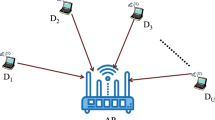Abstract
The usage of mobile nodes is increasing very rapidly and so it is very essential to have an efficient channel allocation procedure for the next generation cellular networks. It is very expensive to increase the existing available spectrum. Hence, it is always better to utilize the existing spectrum in an effective way. In view of this, this paper proposes a channel allocation algorithm for next generation cellular networks which is based on deep learning. The system is made learned deeply to determine the number of channels that each base station can acquire and also dynamically varying based on the time. The originating and handoff calls are two different types of calls being considered in this paper. The number of channels that be exclusively used for originating calls and handoff calls is determined using deep learning. STWQ—Non-LA and STWQ—LAR are used to compare with the proposed work. The results show that the proposed algorithm, DLCA outperforms in terms of blocking and dropping probability.







Similar content being viewed by others
REFERENCES
Naparstek, Oshri and Kobi Cohen, Deep Multi-User Reinforcement Learning for Dynamic Spectrum Access in Multichannel Wireless Networks, arXiv:1704. 02613, 2017.
Agiwal, M., Roy, A., and Saxena, N., Next generation 5G Wireless Networks: A comprehensive survey, IEEE Commun. Surv. Tuts., 2016, vol. 18, no. 3, pp. 1617–1655, thirdquarter 2016. doi 10.1109/COMST.2016. 2532458
Preethi, G., Krishna, P.V., Obaidat, M.S., Saritha, V., and Yenduri, S., Application of deep learning to sentiment analysis for recommender system on cloud, 2017 International Conference on Computer, Information and Telecommunication Systems (CITS), Dalian, 2017, pp. 93–97. doi 10.1109/CITS.2017.803534110.1109/ CITS. 2017.8035341
Saritha, V. and Viswanatham, V.M., Approach for channel reservation and allocation to improve quality of service in vehicular communications, IET Networks, 2014, vol. 3, no. 2, pp. 150–159.
Saritha, V. and Madhu Viswanatham, V., An efficient cross layer based channel reservation method for vehicular networks, Int. J. Commun. Syst., 2014, vol. 27, no. 12, pp. 4249–4264.
Misra, S., Krishna, P.V., and Saritha, V., An efficient approach for distributed channel allocation with learning automata-based reservation in cellular networks, Simulation, V., 2012, vol. 88, no. 10, pp. 1166–1179.
Misra, S., Krishna, P.V., and Saritha, V., LACAV: An energy-efficient channel assignment mechanism for vehicular ad hoc networks, J. Supercomputing (Springer Netherlands), 2012, vol. 62, no. 3, pp. 1241–1262. doi 10.1007/s11227-011-0552-1
Krishna, P.V., Misra, S., Obaidat, M.S., and Saritha, V., An efficient approach for distributed dynamic channel allocation with queues for real time and non-real-time traffic in cellular networks, J. Syst. Software, 2009, vol. 82, pp. 1112–1124. doi 10.1016/j.jss.2009.01.043
Saritha, V., Krishna, P.V., Misra, S., and Obaidat, M.S., Learning automata-based channel reservation scheme to enhance QoS in vehicular adhoc networks, in Global Communications Conference (GLOBECOM), Washington, DC, USA: IEEE, 2016, pp. 1–6.
Misra, S., Krishna, P.V., and V. Saritha, Learning automata based reservation scheme for channel allocation in Wireless Networks, 1st International Conference on e-Technologies and Networks for Development, ICeND 2011, Pahang, Tanzania, 2011, Springer Berlin Heidelberg, pp. 116–126.
Krishna, P.V., Misra, S., Obaidat, M.S., and Saritha, V., A new scheme for distributed channel allocation in cellular Wireless Networks, Proc. of 12th ACM/SCS Communications and Networking Simulation Symposium (CNS), San Deigo, USA, 2009.
Schmidhuber, J., Deep learning in neural networks: An overview, Neural Networks, 2015, vol. 61, pp. 85–117; arXiv:1404.7828. PMID. doi 10.1016/j.neunet.2014. 09.00325462637
Bengio Yoshua, Learning deep architectures for AI, Found. Trends Mach. Learn., 2009, vol. 2, no. 1, pp. 1–127. doi 10.1561/2200000006
Dominic, S. and Jacob, L., Distributed learning approach for joint channel and power allocation in underlay D2D networks, 2016 International Conference on Signal Processing and Communication (ICSC), Noida, 2016, pp. 145–150. doi 10.1109/ICSPCom. 2016.798056510.1109/ICSPCom.2016.7980565
Wu, D., Wu, Q., Xu, Y., and Liang, Y.C., QoE and energy aware resource allocation in small cell networks with power selection, load management, and channel allocation, EEE Trans. Vehicular Technol., 2017, vol. 66, no. 8, pp. 7461–7473. doi 10.1109/TVT.2017. 2650949
Stewart, W., Introduction to the Numerical Solution of Markov Chains, Princeton, NJ: Princeton University Press, 1994, Chapter 3, p. 131.
Ul Hasan, N., Ejaz, W., Ejaz, N., Kim, H.S., Anpalagan, A., and Jo, M., Network selection and channel allocation for spectrum sharing in 5G heterogeneous networks, IEEE Access, 2016, vol. 4, pp. 980–992. doi 10.1109/ACCESS.2016.2533394
Arani, A.H., Mehbodniya, A., Omidi, M.J., and Adachi, F., Learning-based joint power and channel assignment for hyper dense 5G networks, 2016 IEEE International Conference on Communications (ICC), Kuala Lumpur, 2016, pp. 1–7. doi 10.1109/ICC.2016. 751145010.1109/ICC.2016.7511450
Challita, U., Dong, L., and Saad, W., Deep learning for proactive resource allocation in LTE-U networks, European Wireless 2017, 23rd European Wireless Conference, Dresden, Germany, 2017, pp. 1–6. http://ieeexplore.ieee.org/stamp/stamp.isp?tp=&arnumber= 8011311&isnumber=8011282
Wang, C.X. et al., Cellular architecture and key technologies for 5G wireless communication networks, IEEE Commun. Mag., 2014, vol. 52, no. 2, pp. 122–130.
Elsherif, A.R., Chen, W.P., Ito, A., Ding, Z., Adaptive resource allocation for interference management in small cell networks, IEEE Trans. Commun., 2015, vol. 63, no. 6, pp. 2107–2125.
Liu, J.J., Kawamoto, Y., Nishiyama, H., Kato, N., and Kadowaki, N., Device-to-device communications achieve efficient load balancing in LTE-advanced networks, IEEE Wireless Commun., 2014, vol. 21, no. 2, pp. 57–65.
Ren, J., Zhang, Y.X., Zhang, N., Zhang, D.Y., and Shen, X., Dynamic channel access to improve energy efficiency in cognitive radio sensor networks, IEEE Trans. Wireless Commun., 2016, vol. 15, no. 5, pp. 3143–3156.
Xu, Y.H., Anpalagan, A., Wu, Q.H., Shen, L., Gao, Z., and Wang, J., Decision-theoretic distributed channel selection for opportunistic spectrum access: Strategies challenges and solutions, IEEE Commun. Surv. Tuts., 2013, vol. 15, no. 4, pp. 1689–1713.
Author information
Authors and Affiliations
Corresponding authors
Additional information
The article is published in the original.
Rights and permissions
About this article
Cite this article
Sreenivasulu, D., Krishna, P.V. Deep Learning Based Efficient Channel Allocation Algorithm for Next Generation Cellular Networks. Program Comput Soft 44, 428–434 (2018). https://doi.org/10.1134/S0361768818060105
Received:
Published:
Issue Date:
DOI: https://doi.org/10.1134/S0361768818060105




